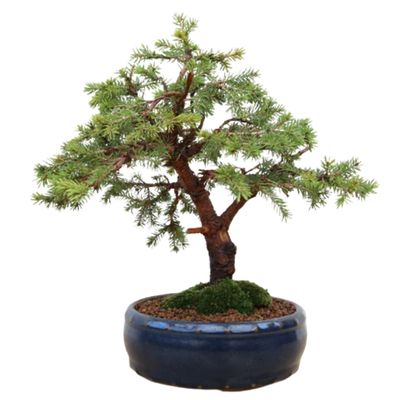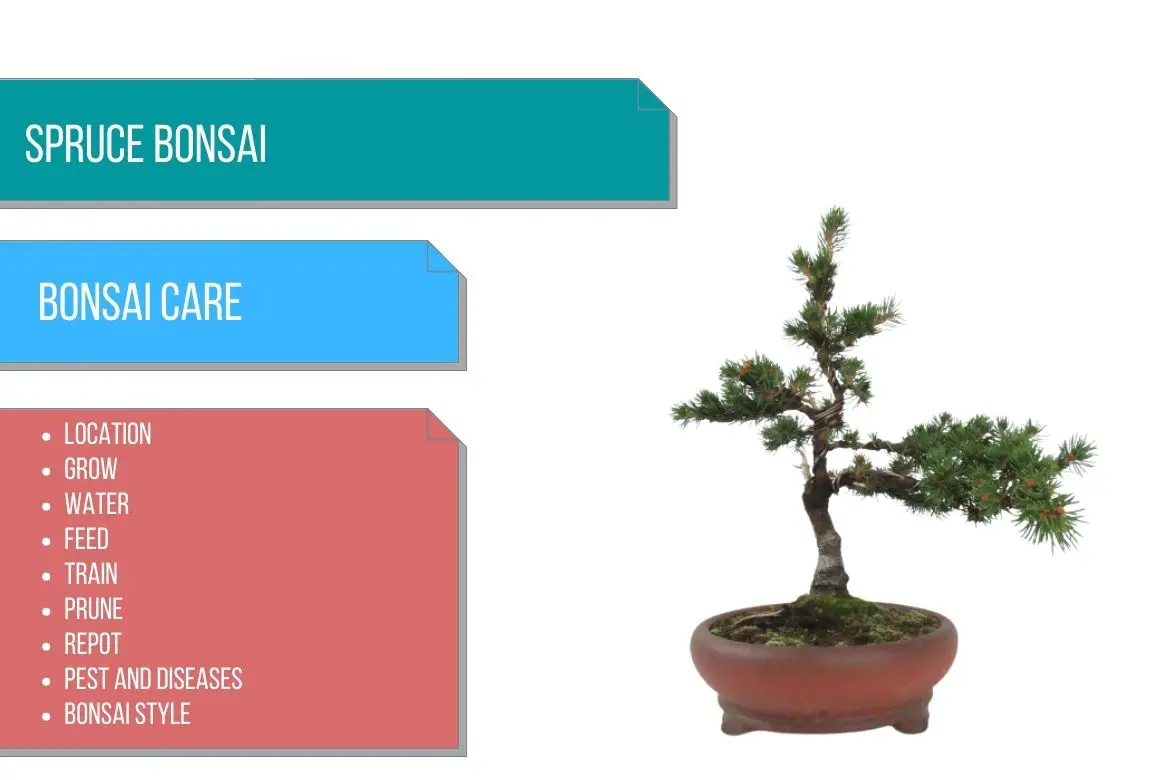
Spruce
(Picea)
Country of Origin : Canada
Bonsai Styles : Informal upright, formal upright, root-over-rock, root-in-rock, group
Zone : 3 – 6
Originally from the northern hemisphere (over 50 species), spruce trees are fast-growing evergreen conifers.
A number of varieties, many of them dwarf, have been bred for ornamental garden plants.
A long-time favorite of Japanese bonsai enthusiasts, it is also used for forest groups and individual specimen bonsai style.
The shallow roots of spruce make them ideal for pot cultivation, and they thrive in crevices in rocks and on slabs.
The color of the foliage, shoots, trunk and branch varies from variety to variety.
There are many varieties of Spruce tree which are used for making bonsai :
- Picea mariana ‘Nana’ : It is also known as dwarf black spruce. It is an dwarf evergreen tree with grayish green needle like foliage.
- Picea glauca ‘Albertiana Conica’ : It is also known as dwarf Alberta white spruce. It is a dwarf evergreen conifer with bright green foliage. It has a conical growth habit.
- Picea abies : It is also known as Norway spruce. It is also evergreen and has reddish shoots. Its needle like foliage is dark green. It produces cylindrical cones.
- Picea abies ‘Maxwellii’ : It is also known as Maxwell’s Norway spruce. It is a dwarf variety of spruce. It has coarse and spiny needle like leaves.
- Picea abies ‘Nidiformis’ : It is also known as Bird’s nest spruce. A dwarf cultivator of spruce with bright green buds.
- Picea abies ‘Echiniformis’ : It is also known as white spruce or hedgehog Norway spruce. It is a slow-growing dwarf variety of spruce. This compact tree produces densely packed foliage.
- Picea abies ‘Little Gem’ : It is also known as Little Gem Norway spruce. This highly popular and desirable dwarf conifer is preferred for its very small leaves and very compact growth habit.
- Picea jezoensis : It is also known as Yezo spruce or Edo spruce. It is an evergreen conifer with dual colored foliage. The needle like leaves are dark green and the underside of the leaves is white. The young shoots produced by this tree are light brown in color.
- Picea jezoensis ‘hondoensis‘ : It is also known as Hondo spruce. This variety of P. jezoensis has shorter leaves form the parent species.
- Picea glehnii : It is also known as Sakhalin spruce. It is an evergreen conifer and is highly preferred for bonsai in Japan. It has bluish green foliage and a slender conical growth habit. It has a flaking bark which is brownish red in color.
Best location to keep Spruce Bonsai
Spruces are hardy trees that can be kept outside all year round without special protection.
In temperate zones, it will tolerate full sun throughout the summer. It is necessary to provide the plant with some shade in warmer climates.
It doesn’t matter what variety of spruce you have, they need cold winters to thrive.
It is important for trees to have periods of low temperatures (almost freezing or below) during the winter in order to remain in good health, however, small trees need to be protected from extreme freezing.
Spruce bonsai should be placed in a shadiest location during the winter if the climate is a little warm.
Keeping winter temperatures above 68°F for successive winters will result in exhaustion of the plant.
Refer sunlight requirements for indoor plants for more indoor gardening ideas. Also, refer to do bonsai trees need sunlight for more indoor and outdoor bonsai location ideas.
Propagation of Spruce
Spruce tree can be propagated by using cuttings in early spring or late fall. In early spring the roots will develop fast from cutting.
Or you can sow stratified seeds in early spring or winter.
Watering Spruce Bonsai
It is possible for forest species to tolerate droughts for short periods of time, but they are generally very thirsty.
Drought tolerance is lower in dwarf varieties, which prefer constantly moist soil.
Throughout the year, water regularly, but increase watering during the summer.
Spruce trees cannot survive in waterlogged soil, so allow the soil to dry slightly between watering sessions.
Ensure that moisture levels are high at all times. Spray water on the foliage to increase humidity.
Read watering bonsai tree for more details.
Wiring Spruce Bonsai
Spruce branches can be wired late in the fall or early in the winter.
Wires can be left on the branches for about an year.
Ensure that needles are not trapped under the wire.
Pruning Spruce Bonsai
When to prune Spruce bonsai?
How to prune Spruce bonsai?
During spring, prune spruce branches back so that only a few needles remain on the branch.
The first flush of shoots should be trimmed hard in spring, but the second flush should be left untrimmed.
However, pruning branches in fall is also a good idea as at this time the pruning wounds will release less resin.
The cut should be made right above a tuft of needles.
Make sure not to cut through the needles.
Pinching Spruce Bonsai
You can pinch out new shoots with your fingers during the growing season.
Pinch out new growth when it reaches about 2.5 cm (1 inch) long. Remove approximately one third of the shoot.
Trees will maintain a compact foliage pad this way, and they won’t become leggy as a result.
Repotting Spruce Bonsai
When to repot Spruce bonsai?
Young spruce bonsai trees can be repotted every second year.
However, when the tree becomes matures (almost 10 years old), you can repot the tree every 4-5 years.
This also depends on if the roots are pot bound.
Early to mid spring (before the buds break) is a good time to repot the tree.
The internodes will become too long if you repot too frequently.
Spruce bonsai trees thrive in soils that are on the acidic side. Alkaline conditions will not be conducive to their growth.
You can use a free-draining, bonsai soil mix.
OR
You can also use a soil mix consisting of 30% grit and 70% organic matter.
OR
Make your own soil mix by mixing sharp sand, leaf mold (or compost) and loam in the ratio of 1:1:1.
Must Read: Bonsai Soil Recipes
Must read : Choosing the right bonsai container
Feeding Spruce Bonsai
Fertilize early in the spring with high-nitrogen fertilizers.
Feed again in late summer, using a general fertilizer this time.
Feed nitrogen-free until fall.
Read more about applying fertilizer to bonsai in bonsai fertilizer and its application.
Diseases and pest of Spruce Bonsai
Aphids and red spider mites attack spruces severely during winter, especially when sheltered. They cluster on new shoots.
Also, these problems can be aggravated by poor air circulation.
A systemic insecticide should be applied if a jet of water cannot remove them.
It is possible for adelgids to cause pineapple-like galls on shoots. A systemic insecticide should also be applied to sap-sucking adelgids.
In most cases, rust is only a temporary problem.
Spruce bonsai care
Trimming spruce requires a specific technique due to its unique properties. As the new shoots emerge from the buds, they resemble tiny green shaving brushes, and they grow into tender shoots adorned with needles.
Unlike many other species, spruce does not produce any new buds from its severed shoots. However, new buds will form at the base of the shoot and at other intersections. It is possible for buds to form as far back as the trunk of a healthy tree.
Approximately every three or four years, old, worn-out, pruned shoots need to be removed.
This should be followed by thinning of dense area so that light can penetrate inside the tree and encourage back budding.
What to look for when buying Spruce Bonsai
While making a purchase, shape is the most important aspect to consider. Bonsai spruces should look like old conifers. The majority of home producers make them look like apple trees.
To be convincing, the trunk should be fairly thick if used as a single specimen.
It is advisable to avoid trees whose foliage has yellowed, which may indicate the presence of spider mites or aphids.
Sakhalin spruce are most commonly used for forest style bonsai, while dwarf spruce are often used for rock plantings.

